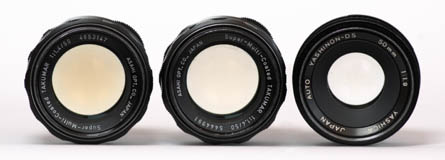Thorium Oxide and Thorium Tetraflouride Optical Coatings
Thorium oxide and thorium tetrafluoride have historically been the preferred optical coatings in lens making for several reasons. Thoria (Thorium dioxide, ThO2) rates 6.5 on the Mohs hardness scale, making it reasonably robust. Both thorium compounds have very high transmission, so their reflectivity values are predictably low. Thoria’s high refractive index (2.20, dNa = 528.29nm; 633nm) places it above diamond (2.42) and roughly equal to zirconia (zirconium dioxide, ZrO2 ; 2.15). This good refractive index leads to very low chromatic dispersion within the range of visible light and into the infrared. This translates into low chromatic aberration, little absorbance or loss of the incoming light. This also holds true for near-infrared cameras. Thoria demonstrates high crystallographic symmetry. It is of the fluorite (cubic) crystal structure (space group: Fm3m). This high symmetry means that, despite its refractive index >2, it exhibits little shearing of the incoming light by non-orthogonal crystallographic planes found in lower symmetry crystals such as zirconia, which exists in three different, room-temperature polymorphs (monoclinic, (P21/c); tetragonal (P42/nmc); cubic (Fm3m)).

Image © El Grafo / CC-BY-SA-4.0
Thorium tetrafluoride (aka “thorium fluoride” [sic], ThF4), although a low-symmetry monoclinic (C12/c1) crystal, demonstrates an exceptionally low refractive index (1.56, dNa = 528.29nm; 633nm) for crystalline solids. Therefore, its low crystal symmetry does not interfere with this material, transparent to a wide range of UV-VIS wavelengths up to and including the infrared (λ = 13μm). Its consistent range of interatomic distances (due to its monoclinicity) permits its deposition onto a number of substrates. Industry experts continue to strive to replace this material with others, but have yet to identify a superior compound.
References:
- Lewis, R.J., Sr (Ed.). Hawley’s Condensed Chemical Dictionary. 13th ed. New York, NY: John Wiley & Sons, Inc. 1997., p. 1103.
- Howard C.J., Hill, R.J., Reichert, B.E. Structures of the ZrO2 Polymorphs at Room Temperature Acta Crystallogr B: Struct. Sci. 1988; 44: 116.
- Terki, R., Bertrand, G., Aourag, H., Coddet, C. Structural and electronic properties of zirconia phases: A FP-LAPW investigations. Mater. Sci. Semicon. Proc. 9. 1006-1013. 2006.
- S. F. Pellicori and E. Colton, “Fluoride Compounds for IR coatings”, Thin Sol. Films 209, 109. 1992.
- Schnellbuegel, A., Hagedorn, H., Anton, R. Ion-assisted deposition of nontoxic coatings for high-power CO2 laser optics,” Proc. SPIE 2253, Optical Interference Coatings, (4 November 1994)


